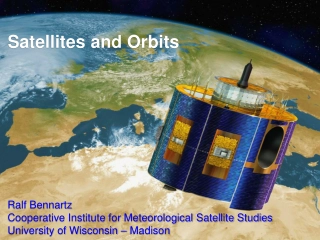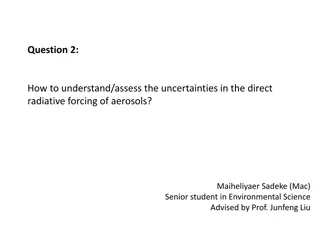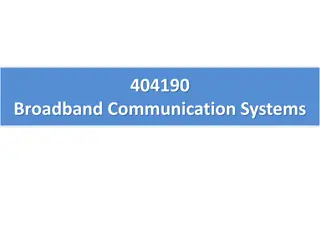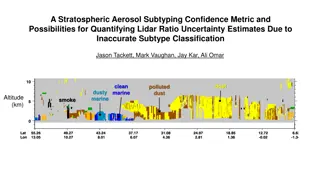Near-UV Satellite Observations for Retrieving Aerosol Properties
Near-UV satellite observations offer a valuable method for retrieving aerosol properties, including aerosol optical depth, absorption, layer height, and surface albedo. These observations provide advantages like sensitivity to aerosol properties and negligible gas absorption interference. However, challenges such as ocean color interference and sensitivity to aerosol layer height exist. Utilizing near-UV channels can enhance aerosol characterization by combining visible and near-UV measurements, contributing to a quantitative understanding of aerosol absorption properties.
Download Presentation

Please find below an Image/Link to download the presentation.
The content on the website is provided AS IS for your information and personal use only. It may not be sold, licensed, or shared on other websites without obtaining consent from the author.If you encounter any issues during the download, it is possible that the publisher has removed the file from their server.
You are allowed to download the files provided on this website for personal or commercial use, subject to the condition that they are used lawfully. All files are the property of their respective owners.
The content on the website is provided AS IS for your information and personal use only. It may not be sold, licensed, or shared on other websites without obtaining consent from the author.
E N D
Presentation Transcript
Fourth TEMPO Science Team Meeting Retrieving Aerosol Absorption Properties of BL aerosols using combined VIS-UV Retrievals Omar Torres NASA-GSFC Washington, DC June 2, 2016
Use of near UV Satellite Observations for retrieving aerosol properties Observations in the 340-400 nm range can be used to derive aerosol properties Advantages: - Low surface albedo at all terrestrial surfaces (.01 to .03 for vegetation; .08 - .12 deserts) - Weak spectral dependence of surface albedo in the 340-400 nm range. - Sensitivity to aerosol absorption. - Negligible gas absorption interference. Disadvantages: - Ocean color interference - Aerosol absorption detection is aerosol layer height sensitive. Historically, near UV measurements have been associated with coarse spatial resolution sensors (TOMS, OMI) primarily designed for trace gas retrieval. At these multi-kilometer resolution sub-pixel cloud contamination is the most important error source in aerosol remote sensing.
Satellite Retrieval Applications Near-UV observations are mainly sensitive to: -Aerosol Optical Depth (wavelength dependent, Aerosol Extinction Exponent) -Aerosol Absorption (wavelength dependent, Aerosol Absorption Exponent) -Aerosol Layer Height -Surface Albedo (second order effect) Even Ignoring Surface effects (small), measured reflectances depend on at least five parameters: AOD, AEE, SSA, AAE, Zae. If measurements at two near-UV channels are available, we may be able to retrieve two parameters. External information or assumptions on the other three are required. In the OMI Algorithm, AOD and SSA are retrieved
From qualitative to quantitative aerosol absorption information Aerosol Single Scattering Albedo and Optical Depth can be simultaneously retrieved. (Height of absorbing aerosol layer must be prescribed) OMI Retrieved Dust Properties (March 9-2007)
Combined VIS-UV retrieval of aerosol properties Independently measured AOD in the visible can be extrapolated to the near UV, and combined with near-UV measured radiances to improve aerosol characterization. For elevated aerosols, retrieve SSA and ZAE For BL aerosols, retrieve, SSA and AAE (or SSA at two near UV channels) Sources of Uncertainty of Independently measured AOD -Sensor Calibration -Surface Characterization -Aerosol Model (SSA and PSD) -Cloud Contamination -Extrapolation Error In the following sensitivity analysis combined uncertainties of 10%, 15% and 20% are assumed
Simultaneous retrieval of aerosol layer height and single scattering albedo
Retrieving single scattering albedo using near UV measurements Single Scattering Albedo Reflectance Function Net Aerosol Reflectance (388nm) 1.0 AOD 0.2 Single Scattering Albedo (388 nm)
Single Scattering Albedo Retrieval Sensitivity to AOD Accuracy SSA (388) = 0.925 SSA(388) = 0.966 10% AOD unc. 15% AOD unc. 20% AOD unc. - More accurate SSA retrievals are obtained for highly accurate AOD values - AOD underestimation leads to SSA overestimation (and vice-versa) - Achievable accuracy is comparable to that of AERONET inversions ( 0.03, red lines above) - SSA retrieval accuracy improves with increasing absorption
Inferring Composition of Boundary Layer Aerosols The wavelength dependence of aerosol SSA is associated with aerosol composition, and commonly expressed in terms of the aerosol Absorption Angstrom Exponent (AAE) AAE ( ) AAOD = 1 1 ( ) AAOD 2 2 AAE values around 1.0 are associated with Black Carbon (wavelength independent imaginary component of refractive index) whereas values as large as 6 values associated with the presence of spectral absorption generally associated with Organic Carbon presence have been observed.
Sample Application Use AERONET AOD measurements at 354 and 388 nm at the GSFC site as proxy of accurate satellite AOD retrievals. Use collocated OMI measured cloud-free reflectances (354 and 388 nm) and AERONET AOD s to a SSA inversion algorithm. Calculate AAE
Sample Retrieval Results -Retrieved AAE and SSA parameters are linearly correlated -OC and BC can be identified based on AAE definition
Concluding Remarks - Aerosol absorption information can be derived from satellite near UV-observations - The main source of uncertainty in derived products from heritage sensors (OMI) is sub-pixel cloud contamination associated with coarse spatial resolution (13x24 km). - Although at TEMPO s finer resolution the cloud contamination problem will be reduced, it will still be the major source of uncertainty of retrieved aerosol products. - High resolution GOES-R ABI visible observations can provide a cloud mask to be used by TEMPO - The combined use of GOES-R visible and TEMPO near UV measurements will allow a better characterization of BL aerosols.























